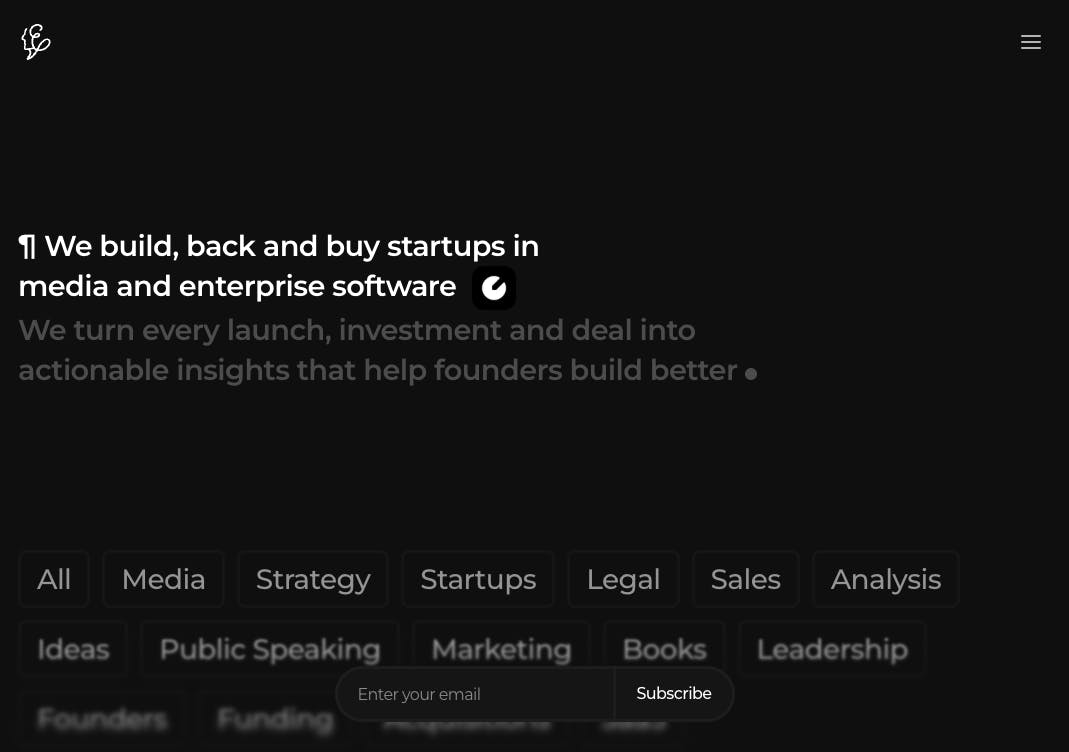Building a venture studio from $0 to mid-five figures per month

Arian Adeli began in fintech, but soon realized that he needed to focus on distribution, so he pivoted to media. After building a portfolio of media brands, Evernomic expanded into a venture studio. And now, he uses his media brands as acquisition channels for his SaaS products and services.
Across his portfolio, he's bringing in mid-five figures per month. Here's Arian on how he's doing it. 👇
A three-pronged portfolio
I run Evernomic, a venture studio that builds and acquires companies in the media sector.
I started coding really young and also got into writing, so I have a background in media. Over the years, I've launched projects across different industries like foodtech, fintech — you name it.
Given my personal passion for media, and also seeing how distribution is becoming more of a bottleneck than technology, I started Evernomic around three years ago as a collection of newsletters and media brands like Internet Is Beautiful. We've since scaled it to a portfolio of 14 startups all across the media sector, from publishing to community platforms to advertising technology to creator tools.
As far as revenue, Evernomic has a few different arms that contribute in different ways:
Advertising: We started with a network of media brands and newsletters, and we still run those today. Through them, and through partner channels, we run advertising and brand campaigns. We're running six figures in annual ad campaigns and growing.
Services: We provide services to other companies across acquisitions, product, content, and growth. The revenue from our services is less predictable, but it's where the majority of our cash flow comes from today.
Products: As for our own products, some of our ventures are already at five-figure MRRs, but most are still in the four-figure range as they grow. The traction is there, and we're starting to see the model compound. The revenue distribution is around 60-40 in favor of non-recurring revenue.
The total revenue is mid-five figures per month.

Building a supporting infrastructure for diverse products
I've been building things since I was very young, jumping between ideas, creating projects, and always trying to make something useful.
I enjoyed doing multiple things at once, but I also saw how inefficient the process could be. Startups have to reinvent the wheel every time, building GTM strategies, setting up analytics and tracking, figuring out revenue models, creating content pipelines, and so on. It's a lot of overhead before you even get to the real problem you're trying to solve.
That's where the idea for Evernomic came from. I wanted to create a structure that supports new ideas — and an ecosystem that accelerates them instead of slowing them down.
So, we've been quietly working on the supporting infrastructure. For the first three years, we focused on building our own projects from scratch. That was intentional because it gave us space to figure out what kind of infrastructure we really needed.
We started by solving our own problems first, building the tools and systems we needed. As our network grew, we expanded that infrastructure to meet the needs of the people we worked with, freelancers, operators, founders, and partners.
Now, it's a flexible support layer that can adapt to whatever a new venture needs, whether it's distribution, execution, or operational help. It's still evolving, but it's become a core part of how we work.
Three big moves in three months
We get better at company building by doing it repeatedly, whether that's starting fresh or taking something that already works and making it bigger.
In the past three months, we've:
A media and tech stack
Most of our products are built with Next.js, deployed on Vercel, and use tools common in that ecosystem like Supabase, Resend, Tailwind CSS, and so on.
For the backend, we sometimes use Python, especially for API work, data processing, and anything more logic-heavy. That setup has worked well across most of our SaaS products.
That's on the tech side, but one of the tools that is crucial to our media side is beehiiv. Game changer for newsletters.
Organic growth
Up until recently, we didn't run paid ads. Being bootstrapped, it was important to keep costs down.
Instead, everything was grown organically through newsletters, side projects, SEO, partnerships, and by just putting our work out there consistently.
We started our portfolio with a few newsletters. We not only used those to promote our products but also leveraged them to partner with other newsletters. We'd request cross-promos with newsletters of a similar size and ask them to promote one of our products instead of our newsletter. So, we'd leverage every newsletter we owned to get placements on several others.
As for SEO, it's primarily directory listings and launchpads. I also wrote some articles on Indie Hackers that helped.
These days, we're running ads on Meta and Google too. We put about $20-50 per day to experiment and expand from there. We've found Meta ads to be a lot more effective for newsletters and such, but Google ads are much better for conversions, since the Search Ads are high intent.
And occasionally sponsor directories, newsletters, or events, but only when they're highly targeted.
Go deeper into what's working
One of the biggest challenges has been consistency, both at a company level and for me, personally. I've always enjoyed working on multiple things at once, and Evernomic's model naturally supports that, but it also makes it easy to fall into shiny-object syndrome. The reality is, great companies are built through focus. By continuously improving, refining, and pushing in the same direction over time.
At some point, I realized it's more effective to build a skyscraper than to keep adding rooms to a bungalow. That shift in mindset, sticking with what's working and going deeper, was a big turning point for us.
If I had to start over, I wouldn't change much. The distractions and pivots were part of the learning curve. But I would've tried to focus down sooner and resist the urge to chase every interesting idea that came up.
Surround yourself
The most helpful thing by far has been surrounding myself with good people, people who can execute, who you can learn from, and who share the vision.
A lot of founders feel like they have to do everything alone, but that's rarely sustainable. We run lean, but everyone's genuinely great at what they do, and our visions are completely aligned.
Be multi-dimensional
Don't be narrow-sighted; have a broader vision for where you're going. A lot of indie hackers focus only on building and completely ignore marketing, distribution, or even talking to people outside their bubble.
Try to be multi-dimensional. Play to your strengths, but also recognize what you're missing, whether that's a co-founder, support network, or just better habits around sharing and selling.
Building alone isn't enough unless you have the right structure around you.
What's next?
We have a lot of goals ahead. Each of our portfolio companies has its own roadmap, but there are a few things I'm especially excited about.
First, we're going more public with Evernomic as a brand. Until recently, we had been building quietly, but we're now making the connection between the brand and the portfolio we've developed over the past few years. We also have two startups currently in stealth that we're getting ready to launch soon.
We're also about to launch the Evernomic Review, our own publication focused on analytical, founder-first content. It will feature insights, experiences, and deep dives from people actually building companies, meant to help others do the same. It's something I've been meaning to launch for a while, and I'm really looking forward to finally putting it out there.
You can follow me on LinkedIn or X. I share updates regularly, especially on LinkedIn. You can also check out our website to learn more about what we're building, though we're still in the process of adding more to it.

Leave a Comment
That’s awesome! I’ve been following Indie Hackers for a while, and your interviews are always packed with great insights. I work in the mobile app niche — mostly around gaming content like FR Legends Mod APK — and I find your approach to storytelling and growth super inspiring.
Evernomic’s journey is incredible — Arian isn’t just building companies, he’s building an entire scalable ecosystem. The mix of focused execution and organic growth is genuinely inspiring.
Great post! I really appreciate how you broke down your journey with Evernomic—from starting at zero, building infrastructure, and scaling into a venture-studio model that drives mid-five-figure monthly revenue. Your emphasis on distribution over just technology, building supporting operations first, and iterating with focus instead of chasing every new shiny idea resonate strongly. Thank you for sharing concrete, actionable insights and being so open about the learning curve. Looking forward to seeing what you build next!